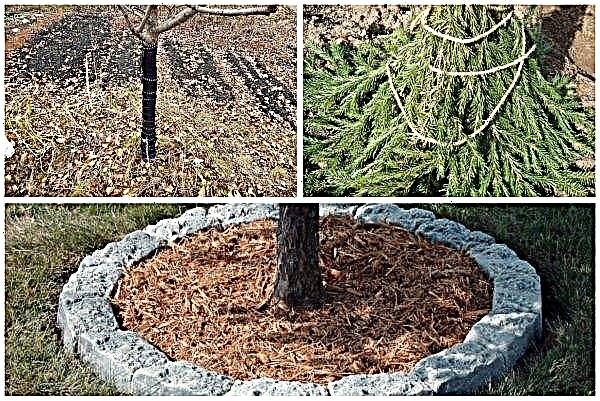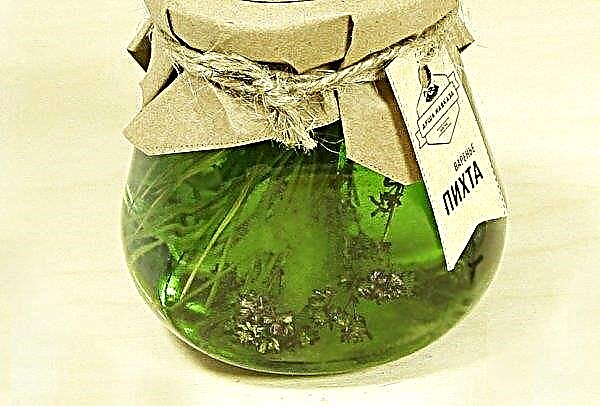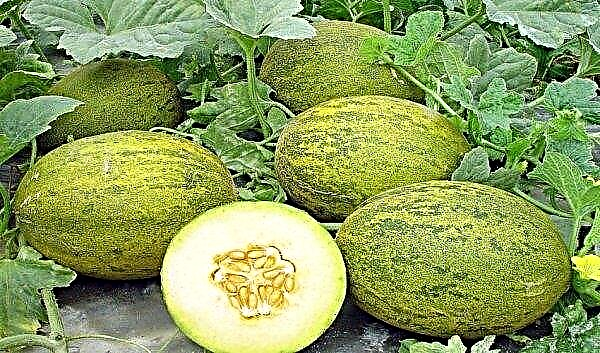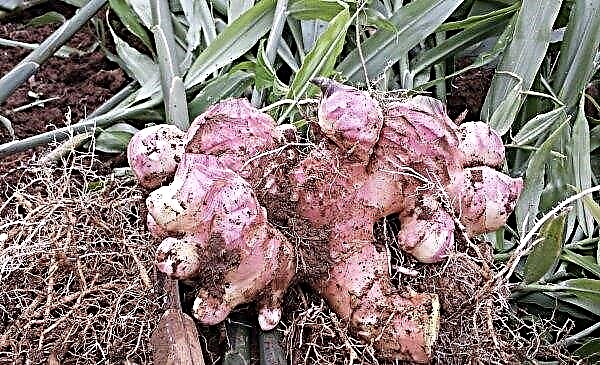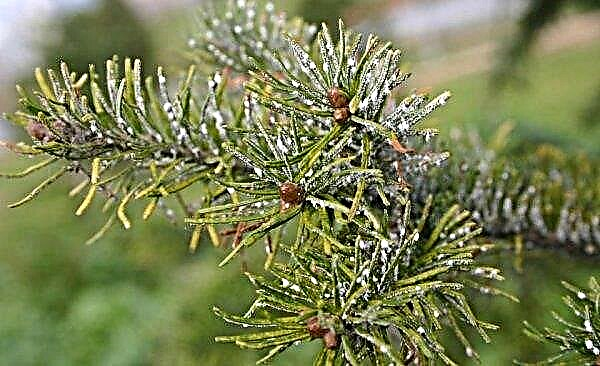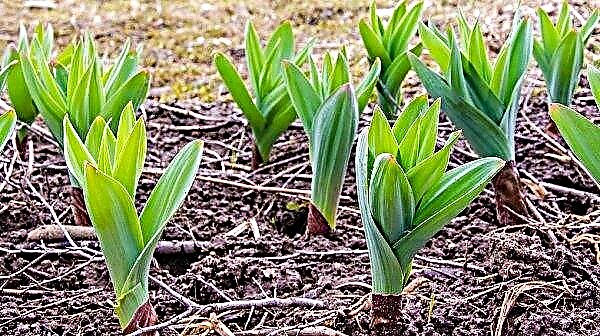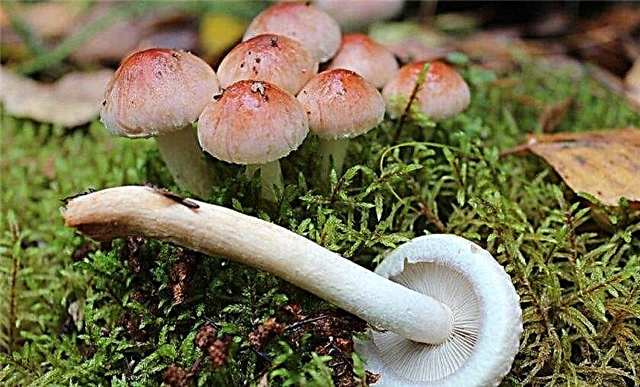Aphid on pepper is a big nuisance for the gardener, which can harm the entire crop. Fortunately, thanks to modern tools and the advice of agronomists, you can get rid of the pest. To solve the problem, growers should understand the causes, symptoms and methods of treating pepper.
What does aphid look like and what is dangerous
The body of the insect is oval, usually about 2-3 mm long; division is poorly expressed. There is a proboscis in front, with which aphids pierce the surface of the plant and suck out the juice. The color of the outer cover depends on the type of insect: the most common is light green, red or black are also found. In each species, there are both wingless forms (providing rapid reproduction) and winged forms (allowing to move to a new habitat).
Did you know? Many species of aphids proboscis can exceed the size of the body several times.
The aphid life cycle consists of several stages. Females lay eggs in the autumn on the bushes, where in spring larvae hatch from them. After molting, wingless forms appear; they breed parthenogenetically, without the participation of a male. Their main task is intensive mass reproduction. Later, pests produce females with wings. Winged individuals fly to neighboring bushes and continue to multiply intensively.
At the end of the summer, male aphids with wings are born. They move to the main plant and participate in further reproduction. Multiplying over generations, insects feed on sap from stems and foliage.
Parasites are extremely dangerous for pepper - the harm they cause to the culture affects not only the yield, but also the general condition of the plants.
With prolonged damage to the bush, they:
- suck plant juices, which inhibit the growth and development of bushes;
- carry infectious diseases;
- secrete a copper pad - a coating that promotes the formation of mold and attracts ants.
Important! Ants contribute to the reproduction of aphids, as they feed on the paddy. Their coexistence accelerates growth retardation and plant death.
Causes and signs of occurrence
Juicy leaves of young pepper themselves attract aphids.
The likelihood of a pest attack increases for three reasons:
- the insect eggs overwintered near the landing site;
- seedlings were sold together with pest larvae;
- aphids attracted ants.
- insects and eggs live on the inside of the foliage;
- sticky coating covers the green parts of the plant;
- the leaves dry and wrap.
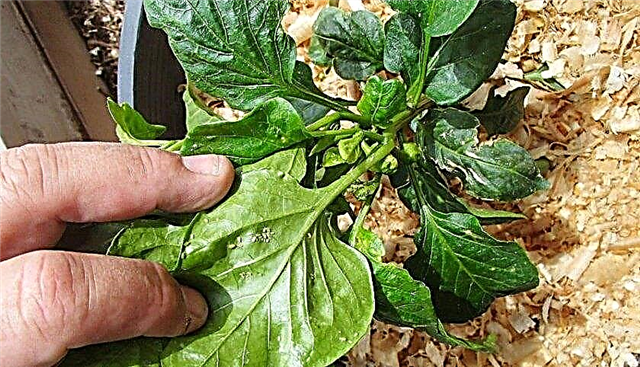
How to remove aphids from pepper in a greenhouse
Summer residents use 3 types of aphids in a greenhouse: mechanical, chemical and folk. Each of them has its own characteristics and is applied according to certain rules.
Mechanical way
The mechanical method is used with a low degree of damage.
Among the most effective ways:
- flush parasites with water pressure from a hose;
- remove from the leaves with a wet rag or sponge;
- remove the affected areas of the tops and burn for the final destruction of the pest.
Chemicals
From the point of view of professional agricultural technology, the biological effectiveness of chemical preparations reaches 90–95%. Insecticides are used to combat aphids.
Among them, the following funds are allocated:
- Actellik. A non-phytotoxic agent that releases fumigants is gaseous pesticides. For spraying, 1 ml of concentrate is introduced per 1 liter of water - this amount is enough to process 5 m² of plantings. Spraying is double, but, according to gardeners, one treatment is enough.
- Aktara. The active substance is thiamethoxam, which does not affect the quality of the fruit. 4 g of "Actara" should be diluted in 5 liters of water. Consumption per 10 m² is 10 liters.
- Karbofos. 60 g of the drug is dissolved in 10 l of water - this amount can be processed 100 m². Spraying is carried out a month before harvesting. The maximum number of applications is 2 times.
- "Fufanon". Insecticide with the active substance malathion. The concentrate should be diluted in water in a ratio of 10 ml per 10 liters. According to the instructions, for better dissolution, the drug is diluted first in a small amount of water, and then the rest of the volume is added. 1–1.5 l of the product is sufficient for processing 10 m².
Important! Pay attention to the warnings in the instructions. For example, Fufanon cannot be combined with other drugs, and Karbofos is dangerous for bees.
Folk remedies
Amateur gardeners often do not want to use pesticides - they believe that chemicals will harm the crop. For this reason, summer residents resort to folk methods.
The following recipes are most often found in anti-aphid recommendations:
- Soap solution. Grate 5 g of laundry soap and dissolve in 1 liter of water. The solution should be brought to a homogeneous consistency. The drug is applied three times to the affected areas by means of a sponge or tissue - thus the pest is washed off the sheet. The method acts like mechanical methods, but the soap at the same time neutralizes the surface of the leaves.
- Infusion of celandine. Grind 350 g of celandine and combine with 1 liter of water, cover the container with the mixture with a lid. After 36 hours, strain the infusion. This tool should be sprayed on a damaged bush.
- Flask of ash and tobacco. Pour 25 g of ash and 25 g of tobacco powder into 1 liter of water, stir to a homogeneous consistency and cover. After 3-4 days, the infusion will be ready. For greater effectiveness, fans of folk remedies recommend adding 20 ml of liquid soap.
- Tomato leaf infusion. Grind 100 g of foliage and stalks of tomato and add to 1 l of water. Cover the container with the mixture and set aside for 4 hours. After this period, bring the solution to a boil and leave to cool for 2.5-3.5 hours. The drug should be used by diluting the indicated amount of 3 liters of plain water.
- Onion infusion. Grind 300 g of onion together with husk and combine with 1 l of cool water. While the mixture is infused, grate 5 g of solid soap. After 5 hours, introduce soap into the infusion, stir until dissolved and pass the liquid through a sieve.
Did you know? When talking about pepper, in the first place they mean characteristic pods of bright red color. However, from a botanical point of view, a plant with such fruits is not a real pepper. If the so-called black pepper (lat. Piper nigrum) belongs to the genus Pepper of the family Peppercorns of the order Pepper, then red pepper (lat. Capsicum annuum) belongs to the genus Capsicum of the Solanaceae family.
Preventive measures
Disease prevention is the best way to preserve pepper plantations and get a good harvest.
In the case of aphids, the preventive measures are as follows:
- disinfect soil and seeds before planting;
- Do not plant bushes in the place where the pest was previously discovered;
- take care of the soil - loosen, remove weeds.
The aphid on pepper in the greenhouse is not afraid of the vegetable grower, who in time notices the attack. Immediately applying one of the methods for its removal, the gardener will forget about the problems with the pest and collect a rich harvest.


